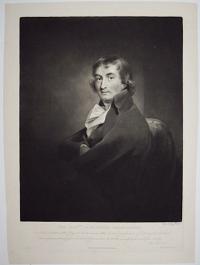
The Hon.ble Alexander Abercromby, One of the Senators of the College of Justice, and one of the Lords Commissioners of Judiciary for Scotland. From a picture in the Possession of Lord Craig to whom this Plate, is respectfully dedicated by his Lordship's Most Ob.t Serv.t Alexander Lawrie.
Engraved by G. Dawe [after Sir Henry Raeburn].
Published Oct.r 22. 1800 by Alex.r Lawrie, Bookseller, Edinburg.
Fine mezzotint. 510 x 355mm (20 x 14"), with large margins.
Alexander Abercromby (1745-1795), Lord Abercromby, younger brother of lieutenant-general Sir Ralph Abercromby. The original portrait seems to date from 1792, when Abercromby was made one of the Lords Commissioners of Justiciary; this mezzotint was not published until five years after his death.
[Ref: 51573] £190.00
(£228.00 incl.VAT)
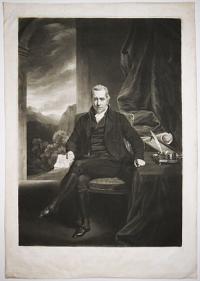
William Adam Esq. 2.nd Fifty.
Painted by John Opie R.A. Engraved by S.W. Reynolds.
Published by S.W. Reynolds, 47 Poland Street, 1804.
Mezzotint. 655 x 455mm (25¾ x 18"), with large margins. Small printer's crease on face, others in background.
William Adam (1751-1839), Scottish barrister, politician and judge. He was the son of architect John Adam and nephew of Robert and James Adam. Through his friendship with the Prince of Wales William received the posts of Solicitor General for Scotland (1802-5), Attorney General to the Prince (1805-6), Chancellor of the Duchy of Cornwall (1806-15), Baron of the Scottish Court of Exchequer (1814-9), Privy Councillor (1815) and Lord Chief Commissioner of the Scottish jury court from 1815 until his death. Adam once shot Charles James Fox in a duel, although they became friends afterwards. Whitman 4, state ii of ii.
[Ref: 51574] £280.00
(£336.00 incl.VAT)
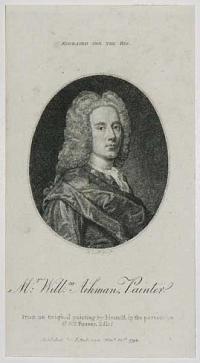
Mr: Will:m Aikman, Painter. Engraved for the Bee.
From an Original painting by himself, in the possession of Mrs. Forbes, Edin.r
Published by J. Anderson, Nov.r 13th. 1793.
Stipple. Sheet 228 x 146mm. 9 x 5¾". Trimmed.
William Aikman (1682-1731), was a portrait painter who studied law at the University of Edinburgh. He took up a career as an artist and, by 1703, was painting portraits professionally in Edinburgh. He sold his family estate near Arbroath to enable him to travel unfettered to Europe to complete his artistic training. Aikman spent three years in Rome, before visiting Turkey and then spent a further period in Rome. He returned to Scotland in 1712, where he made the acquaintance of the poet Allan Ramsay and found an enthusiastic patron in John Campbell, 2nd Duke of Argyll, who persuaded Aikman to move to London. He established a distinguished portrait practice in London, portraying royalty and many members of the aristocracy.
[Ref: 18956] £85.00
(£102.00 incl.VAT)
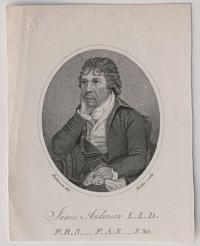
James Anderson L.L.D. F.R.S._F.A.S._S.&c.
Anderson del. Ridley sculp.
[n.d. c.1809.]
Stipple. 146 x 114mm. 5¾ x 4½".
James Anderson (1739-1808) was a Scottish agriculturist, journalist and economist. He was a member of the Edinburgh Philosophical Society and a prominent figure in the Scottish Enlightenment, and invented the Scotch Plough. W: 67.
[Ref: 24572] £50.00
(£60.00 incl.VAT)
![[Dervorguilla de Balliol]](img-thumbnail/jpegs/44077.jpg)
[Dervorguilla de Balliol] Dervorguilla Mater J. Balliol Scot: Regis Fund Coll: Balliolensis Ao. Do. 1266
H. Parker
Mezzotint, sheet 260 x 200mm (10¼ x 8"). Trimmed to image and pasted to album sheet with letterpress below.
Dervorguilla de Balliol, lady of Galloway (d.1290), noblewoman and benefactor. After the death of her husband John de Balliol, Dervorguilla brought together the endowments and formulated the statutes of Balliol College, Oxford, a house of scholars founded as an indirect result of transgressions committed by her husband against the bishop of Durham in 1255. One of a set of 'Founders of Oxford and Cambridge Colleges, Royal Exchange, and Charterhouse' (this impression, bearing the name of H. Parker, is from the final state). CS 34
[Ref: 44077] £150.00
(£180.00 incl.VAT)
![[Dervorguilla de Balliol]](img-thumbnail/jpegs/44076.jpg)
[Dervorguilla de Balliol] Dervorguilla Mater J. Balliol Scot: Regis Fund Coll: Balliolensis Ao. Do. 1266
J: Faber Ao 1732
Mezzotint, sheet 260 x 200mm (10¼ x 8"). Trimmed to image and pasted to album sheet with letterpress below. Loss lower left.
Dervorguilla de Balliol, lady of Galloway (d.1290), noblewoman and benefactor. After the death of her husband John de Balliol, Dervorguilla brought together the endowments and formulated the statutes of Balliol College, Oxford, a house of scholars founded as an indirect result of transgressions committed by her husband against the bishop of Durham in 1255. One of a set of 'Founders of Oxford and Cambridge Colleges, Royal Exchange, and Charterhouse'. CS 34
[Ref: 44076] £90.00
(£108.00 incl.VAT)
![[Henry Blackwood]](img-thumbnail/jpegs/39433.jpg)
[Henry Blackwood] Henricus Blacuodaeus Henrici Filius Parisiensis Doctor Medicus [...]
Cl. Mellan Gall. del et scul [1626]
Etching, sheet 165 x 105mm (6½ x 4"). Trimmed to image.
Henry Blackwood (1588-1634), Scottish physician active in Paris and Rome. Engraved by Claude Mellan (1598-1688), French artist who made this print soon after moving to Rome. In Rome he found a new master in the great painter Simon Vouet. Mellan's simple, spare style makes him one of the most immediately distinctive of all major printmakers. O'D 1; Wellcome: 319-1.
[Ref: 39433] £140.00
(£168.00 incl.VAT)

Archibald Bower Esq.r.
George Knapton pinx.t. J.s Mc.Ardell fecit.
[n.d., c.1760.]
Mezzotint. 350 x 250 (14 x 10"), with large margins, ink stamp of the Duke of Cambridge's collection lower right.
A portrait of Scottish historian Archibald Bower (1686-1766) shown in his library. A religious controversialist and historical writer born near Dundee, Bower entered the Society of Jesus in Rome and lectured at Jesuit colleges in Italy before suddenly leaving Perugia to return to England, allegedly having been discovered in a love affair with a nun. In England Bower converted to the Church of England and wrote about bibliographic history and ancient Rome. His 'History of the Popes', a violent attack on papal supremacy, was published between 1748 and the 1760s. During the publication of the work letters emerged purporting to show that despite his protestant zeal Bower was flirting with Catholicism, shattering his reputation. CS 27 (only state); Whitman 174 ii/ii; L.151.
[Ref: 58003] £260.00
(£312.00 incl.VAT)
![David Brewster [facsimile signature.]](img-thumbnail/jpegs/24468.jpg)
David Brewster [facsimile signature.] Author of 'The Life of Newton'.
Alfred Croquis del.t Daniel Maclise.
[n.d. c.1830.]
Etching. 262 x 203mm. 10¼ x 8".
Sir David Brewster (1781-1868) was a Scottish physicist, mathematician, astronomer, inventor, writer and university principal. In 1855 he issued 'Memoirs of the Life, Writings and Discoveries of Sir Isaac Newton', which embodied the results of more than twenty years' investigation of original manuscripts and other available sources. NPG: D1096. See Wellcome: 417-2.
[Ref: 24468] £75.00
(£90.00 incl.VAT)

Georgius Buchananus: Aeta: suae 76.
Esme de Boulonois fecit.
[n.d. c.1682.]
Engraving. 188 x 140mm. 7½ x 5½".
Published in Isaac Bullart's 'Académie des Sciences et des Arts'. George Buchanan (1506-1582) was a Scottish historian and humanist scholar. He was part of the monarchomach movement, which consisted of Huguenot theorists who opposed absolute monarchy. Monarchomachs were people who opposed absolutism, believing that sovereignty belonged to the people, but the irony here was that "the people" for monarchomachs in fact only meant to refer to the bourgeoisie and nobility, never the popular masses. Buchanan was a key figure in developing the monarchomach theories in Scotland. Similar to Erasmus, Buchanan had the same ideas about the Catholic church, and was persecuted like all Lutherans in 1539, however he managed to effect his escape, and fled to London and then onto Paris. It was here where faced with further persecution, he accepted an invitation by Andre de Gouveia to take on the post of professor of Latin at the College of Guienne at Bordeaux.
[Ref: 17104] £50.00
(£60.00 incl.VAT)

Georgius Buchananus Aeta Suae 76. Scotia fi Vatern hunc gelidam produxit ad arcton, Credo equidem gelidj percaluere polj.
I CH f.
[n.d. c.1669.]
Engraving. 120 x 89mm. 4¾ x 3½".
George Buchanan (1506-1582) was a Scottish historian and humanist scholar. He was part of the monarchomach movement, which consisted of Huguenot theorists who opposed absolute monarchy. Monarchomachs were people who opposed absolutism, believing that sovereignty belonged to the people, but the irony here was that "the people" for monarchomachs in fact only meant to refer to the bourgeoisie and nobility, never the popular masses. Buchanan was a key figure in developing the monarchomach theories in Scotland. Similar to Erasmus, Buchanan had the same ideas about the Catholic church, and was persecuted like all Lutherans in 1539, however he managed to effect his escape, and fled to London and then onto Paris. It was here where faced with further persecution, he accepted an invitation by Andre de Gouveia to take on the post of professor of Latin at the College of Guienne at Bordeaux. Portrait from: 'Bibliotheca Chalcographica, hoc est Virtute et eruditione clarorum Virorum Imagines' by Jean Jacques Boissard. The work with 100 portraits was first published under the title 'Icones virorum illustrium' in 1597-98.
[Ref: 24622] £120.00
(£144.00 incl.VAT)

Geo. Buchanani Scoti Opera.
Andr Johnston Excud. M. Vdr. Gucht Sculp.
Edimburgi, apud Robertum Fribarnum Typographum Regium Ano. Dom. MDCCXV. [Edinburgh: Robert Freebairn, 1715.]
Engraved titlepage to 'Georgii Buchanani ... opera omnia, ad optimorum codicum fidem summo studio recognita & castigata [Works]...' by George Buchanan. 350 x 210mm, 13¾ x 8¼". Worm hole to left edge of plate.
Allegorical and classical figures with putti surround the bust of George Buchanan (1506 - 1582), Scottish historian, scholar and poet. The composition includes a harp, lyre and trumpets; the royal arms of Scotland lower right. Educated at the Universities of St Andrews and Paris, Buchanan taught in Paris until his return to Scotland in 1536. Condemned as a heretic, he was imprisoned in the castle of St Andrews before escaping into exile in France in 1539. He held professorships at Bordeaux and Paris, and later at Coimbra, Portugal, where he was put on trial for heresy in 1550-01. He returned to Scotland in 1561 and tutored Mary, Queen of Scots. Initially loyal to the Queen, he later testified against her at her trial for the assassination of her husband, Lord Darnley. He became principal of St Leonard's College in St Andrews in 1566. His most substantial work, Rerum Scoticarum Historia, a history of Scotland, was published in Latin in 1582. British Library: 000513218.
[Ref: 13597] £140.00
(£168.00 incl.VAT)

Georgius Buchananus. Aetat: LXXVI.
R: Blokhuysen Fecit.
[n.d., c.1710.]
Rare. Engraved frontispiece/dedication, sheet 210 x 165mm. 8¼ x 6½". Trimmed to plate.
Bust in an alcove of George Buchanan (1506 - 1582), Scottish historian, scholar and poet; 16 lines of tribute in Latin by the author Pieter Shrijver to pedestal below, profiles of Mary Queen of Scots and James VI right and left. Educated at the Universities of St Andrews and Paris, Buchanan taught in Paris until his return to Scotland in 1536. Condemned as a heretic, he was imprisoned in the castle of St Andrews before escaping into exile in France in 1539. He held professorships at Bordeaux and Paris, and later at Coimbra, Portugal, where he was put on trial for heresy in 1550-01. He returned to Scotland in 1561 and tutored Mary, Queen of Scots. Initially loyal to the Queen, he later testified against her at her trial for the assassination of her husband, Lord Darnley. He became principal of St Leonard's College in St Andrews in 1566. His most substantial work, Rerum Scoticarum Historia (lower left of bust), a history of Scotland, was published in Latin in 1582.
[Ref: 13155] £140.00
(£168.00 incl.VAT)
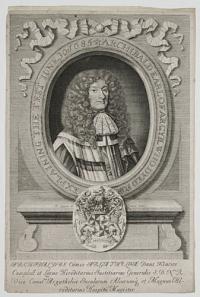
Archibaldu Earl of Argull Who Dyed for Explaining the Test Iune 30 1685. Archibaldus Comes Argatheliae Dnus. Kintire Campbell et Lorne Hereditarius Justitiarius Generalis S.D.N.R. Vice Cometus Argatheliae Insularum Aliarumque et Magnus Hereditarius Hospitii Magister.
D. Loggan ad Vivum delin.
[n.d. c.1680; but later.]
Engraving. 305 x 202mm (12 x 8").
Portrait of Archibald Campbell (1629-1685), ninth Earl of Argyll, head and shoulders in an oval frame, long hair, wearing cravat and robes; coat of arms below. As colonel of the Foot Guards he fought in the Battle of Dunbar in 1650 and the Battle of Worcester in 1651 for Charles II. In 1663 he was elected a Fellow of the Royal Society. He was a confederate of Monmouth and 1681 he was found guilty of High Treason and sentenced to death for refusing to subscribe to the Test Act. He escaped from Edinburgh Castle under the disguise of a page. He then left the country but four years later was taken in an abortive attempt to invade Scotland and was beheaded. Ex Collection: Norman Blackburn. See 24663 for earlier impression.
[Ref: 24662] £120.00
(£144.00 incl.VAT)
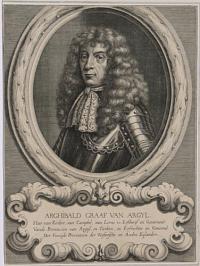
Arghibald Graaf Van Argyl. Heer van Kinlire, van Campbel, van Lorne &. Erfsherif en Governeur Vande Provincen van Argyl, en Turben, en Erfrechter en Generael Der Geseyde Provintien der Westersche en Andre Eylanden.
[Adriano Haelwegh Fecit.]
[n.d., c.1680.]
A rare engraving. Sheet: 330 x 240mm (13 x 9½"). Trimmed within plate and laid on album sheet.
Archibald Campbell, ninth Earl of Argyll (c. 1629 - 1685) a confederate of James Duke of Monmouth, and who was imprisoned for refusing to subscribe to the Test Act in 1681 and sentenced to death. He escaped from Edinburgh castle and left the country but four years later was taken in a abortive attempt to invade Scotland and beheaded. By Adrian Haelwegh, Dutch printmaker (c.1637 - 1702). He worked in Amsterdam, primarily on portraits and book illustrations.
[Ref: 43068] £260.00
(£312.00 incl.VAT)

Arghibald Graaf Van Argyl. Heer van Kinlire, van Campbel, van Lorne &. Erfsherif en Governeur Vande Provincen van Argyl, en Turben, en Erfrechter en Generael Der Geseyde Provintien der Westersche en Andre Eylanden.
Adriano Haelwegh Fecit.
[n.d., c.1680.]
Etching, sheet 342 x 251mm. Trimmed into plate and glued to album page at corners.
Archibald Campbell, ninth Earl of Argyll (c. 1629 - 1685), Earl from 1663 following the restoration of the title two years after his father, the Marquess of Argyll, was executed for treason. Although he shared few of his father's political convictions, displaying little enthusiasm for the Covenants, he too was destined to be executed. A confederate of James Duke of Monmouth, for refusing to subscribe to the Test Act, was found guilty of High Treason in 1681 and sentenced to death. He escaped from Edinburgh castle under the disguise of a page, holding up the train of Lady Sophia Lindsay, his step daughter. He left the country but four years later was taken in a abortive attempt to invade Scotland and beheaded. A fine impression, with inscription set into decorative cartouche, by Adrian Haelwegh, Dutch printmaker (c.1637 - 1702). He worked in Amsterdam, primarily on portraits and book illustrations. Apparently in Italy in 1660s. BM: pg.67, 2.
[Ref: 7538] £220.00
(£264.00 incl.VAT)
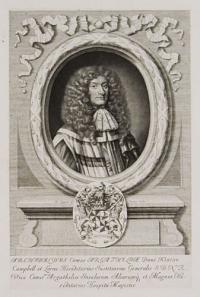
Archibaldus Comes Argatheliae D.nus Kintire Campbell et Lorne Hereditarius Justitiarius Generalis S.D.N.R. Vice Comet.us Argatheliae Insularum Aliarumque et Magnus Hereditarius Hospitii Magister.
D. Loggan ad Vivum delin.
[n.d. c.1690.]
Rare engraving. 296 x 190mm (11¾ x 7½"). Trimmed and laid on old card.
Portrait of Archibald Campbell (1629-1685), ninth Earl of Argyll, head and shoulders in an oval frame, long hair, wearing cravat and robes; coat of arms below. As colonel of the Foot Guards he fought in the Battle of Dunbar in 1650 and the Battle of Worcester in 1651 for Charles II. In 1663 he was elected a Fellow of the Royal Society. He was a confederate of Monmouth and 1681 he was found guilty of High Treason and sentenced to death for refusing to subscribe to the Test Act. He escaped from Edinburgh Castle under the disguise of a page. He then left the country but four years later was taken in an abortive attempt to invade Scotland and was beheaded. Ex Collection: R. Hobson of Hove.
[Ref: 25404] £120.00
(£144.00 incl.VAT)
![[Archibald Campbell, 1st Marquess of Argyll] Lo here, the Genius of the great Arguyle](img-thumbnail/jpegs/12548.jpg)
[Archibald Campbell, 1st Marquess of Argyll] Lo here, the Genius of the great Arguyle Whose Politicks and Ethicks in one pyle Like Anchor Buoys, appeare to teach thee Wit To shun those rocks on which himselfe was split.
[n.d. c.1715.]
Engraving. 126 x 76mm.
Archibald Campbell (1598-1661), 1st Marquess of Argyll, 8th Earl of Argyll, chief of Clan Campbell, the de facto head of government in Scotland during most of the conflict known as the Wars of the Three Kingdoms. He was the most influential figure in the Covenanter movement that fought for the Presbyterian religion and what they saw as Scottish interests during the English Civil War of the 1640s and 1650s. He was made a privy councillor in 1628. In 1638, the king summoned him, together with Traquair and Roxburgh, to London, but he refused to be won over, warned Charles against his despotic ecclesiastical policy, and showed great hostility towards William Laud. In consequence, a secret commission was given to the Earl of Antrim to invade Argyll and stir up the MacDonalds against him in January 1644, he accompanied the Scottish army into England as a member of the committee of both kingdoms and in command of a troop of horse, but was soon compelled, in March, to return to suppress royalists in the Scottish Civil War and to defend his own territories. At the Restoration, he presented himself at Whitehall, but was at once arrested by order of Charles and placed in the Tower (1660), being sent to Edinburgh to stand trial for high treason. He was acquitted of complicity in the death of Charles I, and his escape from the whole charge seemed imminent, but the arrival of a packet of letters written by Argyll to Monck showed conclusively his collaboration with Cromwell's government, particularly in the suppression of Glencairn's royalist rising in 1652. He was immediately sentenced to death, his execution by beheading taking place on 27 May 1661, before the death warrant had even been signed by the king. His head was placed on the same spike upon the west end of the Tolbooth as that of Montrose had previously been exposed, and his body was buried at the Holy Loch, where the head was also deposited in 1664.
[Ref: 12548] £120.00
(£144.00 incl.VAT)

Lord Frederick Campbell, Lord Register of Scotland. And One of his Majesty's most Honourable Privy Council.
Thos. Gainsborough pinxt: G. Dupont Sculpt.
[n.d., c.1785.]
Fine Mezzotint, 270 x 195mm. 10½ x 7¾".
Portrait in oval of Lord Frederick Campbell (1729 - 1816), Lord Clerk Register of Scotland; son of John, 4th Duke of Argyll MP. After Thomas Gainsborough (1727 - 1788). Chaloner Smith: 1. Horne: 15 only state.
[Ref: 18840] £320.00

The Right Honourable Lord Frederick Campbell, In 1765 Appointed a Privy Councellor and keeper of the Privy Seal of Scotland, which he resigned in 1767, and was appointed Chief Secretary to the Lord Leiutenant of Ireland; In 1768 Lord Clerk Register of Scotland; In 1787 Vice Treasurer of Irelandm In 1800 A Commissioner of the Public Records of Great Britain. he was also a Commissioner for the Affairs of India, & of Trade & Plantations: and a Trustee of the British Museum. Died June 8th 1816, Aged 87.
H. Edridge Esq,r Pinx.t. 1812. James Stow Sculp.t.
London, Published Jan.y 1st 1817 byG.P. Harding, 38, Strand.
Stipple. 440 x 360mm (17¼ x 14¼"). Damp staining at top in margins and foxing in margins.
Portrait of Lord Frederick Campbell (1729-1816), Lord Clerk Register of Scotland from 1768 until his death. The third son of John Campbell, 4th Duke of Argyll, he was also MP for Glasgow Burghs (1761-80) and Argyllshire (1780-99).
[Ref: 48143] £190.00
(£228.00 incl.VAT)

[Colonel John Campbell, Who Succeeded to the Dukedom of Argyll in April 1761.]
[Jonathan Richardson Pinx.t 1721. James Basire Sculp.t.]
[n.d., c.1761.]
Engraving, scarce proof before engraved border and letters. Sheet 250 x 305mm (8 x 12"). Trimmed within plate.
General John Campbell (1693-1770), 4th Duke of Argyll, Governor of Limerick and Privy Councillor, painted as a young man of 28, with a drawing book on his lap. He was already a lieutenant colonel and had served two terms in Parliament. This portrait was probably published when he succeeded to the dukedom. See NPG D32570 for lettered state. See Ref: 13909 & 32570 for lettered impression.
[Ref: 59409] £450.00
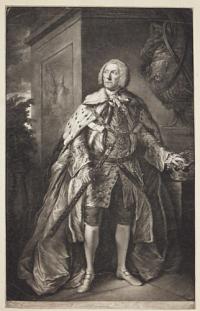
[John Duke of Argyll. Hereditary Great Master of the Household in Scotland, Colonel of His Majesty's Grey Dragoons, Governor of Limerick, General of Horse & Kn.t of the most Antient Order of the Thistle.]
Tho.s Gainsborough Pinx.t. J. Watson fecit.
J. Boydell excudit Jan.ry 12th 1769.
Fine mezzotint, scratched-letter proof before title. 620 x 390mm (12½ x 15¼"). Trimmed into plate at bottom, thread margins elsewhere, mounted on album sheet, some creasing.
Full length portrait of John Campbell (General John Campbell (c.1693-1770), 4th Duke of Argyll, wearing peer's robes, the chain of the Order of the Thistle, one hand on his coronet, the other holding the baton of Hereditary Master of the King's Household. Gainsborough's original oil is part of the National Galleries of Scotland's collection at Duff House. CS 4 i of ii.
[Ref: 43495] £450.00

Colonel John Campbell, Who Succeeded to the Dukedom of Argyll in April 1761.
Jonathan Richardson Pinx.t 1721. James Basire Sculp.t.
[n.d., c.1780.]
Engraving. Sheet 320 x 355mm (12¼ x 13¾"). Trimmed.
General John Campbell (1693-1770), 4th Duke of Argyll, Governor of Limerick and Privy Councillor, painted as a young man of 28, with a drawing book on his lap. He was already a lieutenant colonel and had served two terms in Parliament. NPG D32570.
[Ref: 13909] £180.00
(£216.00 incl.VAT)

Colonel John Campbell, Who Succeeded to the Dukedom of Argyll in April 1761.
Jonathan Richardson Pinx.t 1721. James Basire Sculp.t.
[n.d., c.1761.]
Engraving. 350 x 495mm (13¾ x 19½"). Trimmed within plate at sides. Very slight creasing.
General John Campbell (1693-1770), 4th Duke of Argyll, Governor of Limerick and Privy Councillor, painted as a young man of 28, with a drawing book on his lap. He was already a lieutenant colonel and had served two terms in Parliament. This portrait was probably published when he succeeded to the dukedom. NPG D32570.
[Ref: 56442] £180.00
(£216.00 incl.VAT)
![John Douglas Edward Henry [Campbell]](img-thumbnail/jpegs/52845.jpg)
John Douglas Edward Henry [Campbell] Seventh Duke of Argyll.
Painted by Sir W.m Ross RA 1843. Engraved by Ja.s Posselwhite,
London, Published by Thomas McLean, 26, Haymarket, April 20th 1847.
Stipple. Sheet 250 x 180mm (9¾ x 7"). Trimmed within plate, mounted in album paper.
John Campbell (1777-1847), with kilt, sporran and claymore.
[Ref: 52845] £70.00
(£84.00 incl.VAT)

The R.t Hon.ble the Earl of Loudoun. Capt.n General & Governour in Chief, of his Majestys Forces in North America: and one of the Sixteen Peers of Scotland.
Lond: Mag.
[n.d., c.1760.]
Engraving. Sheet: 200 x 115mm (8 x 4½''). Trimmed.
A full-length portrait of Scottish nobleman and army officter John Campbell, 4th Earl of Loudoun (1705-1782).
[Ref: 48687] £140.00
(£168.00 incl.VAT)
![Alex Chalmers [facsimile signature].](img-thumbnail/jpegs/35349.jpg)
Alex Chalmers [facsimile signature].
Drawn on stone by R.J.Lane A.R.A
[n.d., c.1830].
Lithograph. Sheet: 185 x 240mm (7 x 9½").
Half portrait of Scottish writer and journalist Alexander Chalmers (1759-1934). Chalmers originally trained as a doctor but gave up medicine to pursue writing. As well as publishing various editions of works by writers such as Pope, Shakespeare and Johnson, Chalmers published a 'General Biographical Dictionary' (1812-17) and a 'Glossary to Shakespeare' (1807).
[Ref: 35349] £70.00
(£84.00 incl.VAT)
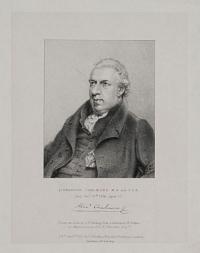
Alexander Chalmers M.A. and F.S.A. Died Dec.r. 10.th. 1834, Aged 75.
Drawn on Stone by G.P.Harding from a drawing by W.Behnes in the possession of E.N.Thornton Esq.re.
Pub.d. June 15.th 1837, by G.P.Harding, Hercules Buildins, Lambeth. Day & Haghe Lith.rs. to the King.
Lithograph. On India. Sheet: 220 x 290mm (8¾ x 11½"). Some slight foxing and surface dirt. Large margins.
Half portrait of Scottish writer and journalist Alexander Chalmers (1759-1934). Chalmers originally trained as a doctor but gave up medicine to pursue writing. As well as publishing various editions of works by writers such as Pope, Shakespeare and Johnson, Chalmers published a 'General Biographical Dictionary' (1812-17) and a 'Glossary to Shakespeare' (1807).
[Ref: 35348] £70.00
(£84.00 incl.VAT)

The Honourable Francis Charteris Esqr.
J. Reynolds pinxt. Rd. Houston fecit.
[n.d. c.1757.]
Mezzotint, with large margins. Plate 330 x 228mm. 13 x 9".
Francis Wemyss Charteris (1723-1808) was a Scottish landowner, 6th Earl of Wemyss. His elder brother David, Lord Elcho, was implicated in the Jacobite Rising of 1745, and was attainted in 1746, and died childless in 1787, therefore Charteris inherited the title as 7th Earl of Wemyss. Hamilton: p.17, ii. CS: 27, ii.
[Ref: 24767] £140.00
(£168.00 incl.VAT)

Alexander Cruden, M. A.
Drawn from the Life by T Fry. Engravd by T Trotter.
Published as the Act directs for C. Dilly; and the rest of the Proprietors in London, May 5th 1785.
Etching, published state, frontispiece to Cruden's 'A Complete Concordance to the Holy Scriptures...' 240 x 185mm, 9½ x 7¼". A fine impression.
Bust portrait in oval frame of Alexander Cruden (1701 - 1770), 'a pious Scot of enormous industry and pendantry' (Martin Gayford, 'Constable in Love'). Cruen was author of the 'Biblical Concordances' (J. Buckland, 1785); coat-of-arms below. After Thomas Frye (c.1710 - 1762). See BL 467.d.9.
[Ref: 22386] £75.00
(£90.00 incl.VAT)

Alexander Cruden, M. A.
Drawn from the Life by T Fry. Engravd by T Trotter.
[London: C. Dilly; 1785.]
Etching, scratched-letter state, frontispiece to Cruden's 'A Complete Concordance to the Holy Scriptures...' 240 x 185mm, 9½ x 7¼". A fine impression.
Bust portrait in oval frame of Alexander Cruden (1701 - 1770), 'a pious Scot of enormous industry and pendantry' (Martin Gayford, 'Constable in Love'). Cruden was author of the 'Biblical Concordances' (J. Buckland, 1785); coat-of-arms below. After Thomas Frye (c.1710 - 1762). See BL 467.d.9.
[Ref: 22387] £95.00
(£114.00 incl.VAT)

Samuel Cullen, M.D.
McIntyre sculp.t.
[n.d., c.1810.]
Stipple. Sheet size: 135 x 95mm (5¼ x 3¾"). Trimmed inside platemark. Laid on scrap sheet.
A portrait of Scottish physician, chemist and agriculturalist, William Cullen (1710 - 1790). Cullen was one of the most important professors at the Edinburgh Medical School, as the leading center of medical education in the English-speaking world. He was President of the Royal College of Physicians and Surgeons of Glasgow (1746–7), President of the Royal College of Physicians of Edinburgh (1773–1775) and First Physician to the King in Scotland (1773–1790). Cullen was also a successful author. He published a number of medical textbooks, mostly for the use of his students, though they were popular throughout Europe and the American colonies as well. His best known work was 'First Lines of the Practice of Physic', which was published in a series of editions between 1777 and 1784. Wellcome: 725-10.
[Ref: 34468] £50.00
(£60.00 incl.VAT)
![Yours always Allan Cunningham [pen facsimile.]](img-thumbnail/jpegs/24483.jpg)
Yours always Allan Cunningham [pen facsimile.]
H. Room. 85. J. Thomson.
[Published by George Virtue. 1840.]
Stipple. 222 x 146mm. 8¾ x 5¾".
Allan Cunningham (1784-1842) was a Scottish poet and author. He contributed some songs to Roche's "Literary Recreations" in 1807 and two years later he submitted several ballads for Robert Cromek's "Remains of Nithsdale and Galloway Song". In 1810 he moved to London and worked as a journalist until in 1814 he became secretary to sculptor, Francis Chantrey. NPG: D34428.
[Ref: 24483] £50.00
(£60.00 incl.VAT)
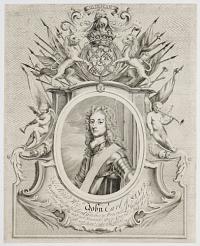
The Right Hon.ble John Earl of Stair Viscount Dalrymple Lord Glenluce & Stranraer Lt. General of his maj.ties Forces [...]
[Anon., c.1740]
Engraving, very rare; sheet 335 x 270mm (13¼ x 10½"). Trimmed.
John Dalrymple, second earl of Stair (1673-1747), diplomat and army officer. Dalrymple's early career was characterized by military service during the Nine Years' War; the duke of Marlborough became Dalrymple's mentor and patron. After succeeding his father as Earl of Stair he became ambassador to Paris, attempting to combat the threat of Jacobitism and contributing to the eventual removal of the Jacobite court to Italy (Sir Winston Churchill considered him 'one of the most capable ambassadors...ever sent to Paris'). Stair withdrew from politics in the 1720s, dedicating himself to agricultural reform, before rehabilitating himself after the fall of Robert Walpole, when he became (non-resident) governor of Minorca.
[Ref: 42897] £280.00
(£336.00 incl.VAT)

George Dempster Esq. [European Magazine]
Published 1 Aug 1793 by J. Sewell 32 Cornhill
Engraving, 160 x 110mm (6 x 4"). Trimmed inside platemark, losing 'European Magazine' text; false margins added.
George Dempster (1732-1818), agriculturist and politician. Dempster studied law but turned his back on the legal profession to go into politics. Having inherited family estates of some 6000 acres, he was able to finance a campaign as candidate for the (notoriously corrupt) Perthshire district of burghs, which he won against the odds, but at crippling costs. Dempster strengthened his position in subsequent elections (he was MP for 28 years), but had to sell around 2500 acres of land to cover his costs. Dempster was known for his independence, voting against the Stamp Act and opposing government attempts to oppress the colonists in America. He retired from politics in 1789. Dempster also developed an interest in India, becoming director of the East India Company in 1769 and 1772. He defended Warren Hastings against the Edmund Burke's campaign of impeachment. Dempster was also famous for his efforts to advance Scottish commerce and manufactures, promoting the textile industry, founding the first bank in Dundee (having noticed that the lack of proper banking facilities hampered trade), leading improvements to fisheries and promoting road building. He also carried out significant agricultural improvements on his own land and encouraged other landowners to follow his example. Plate from the 'European Magazine'. O'D 1
[Ref: 35304] £60.00
(£72.00 incl.VAT)

George Dempster Esq. [European Magazine]
Published 1 Aug 1793 by J. Sewell 32 Cornhill
Engraving, 155 x 105mm (6 x 4"). Trimmed inside platemark, losing 'European Magazine' text.
George Dempster (1732-1818), agriculturist and politician. Dempster studied law but turned his back on the legal profession to go into politics. Having inherited family estates of some 6000 acres, he was able to finance a campaign as candidate for the (notoriously corrupt) Perthshire district of burghs, which he won against the odds, but at crippling costs. Dempster strengthened his position in subsequent elections (he was MP for 28 years), but had to sell around 2500 acres of land to cover his costs. Dempster was known for his independence, voting against the Stamp Act and opposing government attempts to oppress the colonists in America. He retired from politics in 1789. Dempster also developed an interest in India, becoming director of the East India Company in 1769 and 1772. He defended Warren Hastings against the Edmund Burke's campaign of impeachment. Dempster was also famous for his efforts to advance Scottish commerce and manufactures, promoting the textile industry, founding the first bank in Dundee (having noticed that the lack of proper banking facilities hampered trade), leading improvements to fisheries and promoting road building. He also carried out significant agricultural improvements on his own land and encouraged other landowners to follow his example. Plate from the 'European Magazine'. O'D 1
[Ref: 35303] £50.00
(£60.00 incl.VAT)

George Dempster Esq. [European Magazine]
Published 1 Aug 1793 by J. Sewell 32 Cornhill
Engraving, 150 x 110mm (6 x 4"). Trimmed inside platemark, losing 'European Magazine' text; false margins added.
George Dempster (1732-1818), agriculturist and politician. Dempster studied law but turned his back on the legal profession to go into politics. Having inherited family estates of some 6000 acres, he was able to finance a campaign as candidate for the (notoriously corrupt) Perthshire district of burghs, which he won against the odds, but at crippling costs. Dempster strengthened his position in subsequent elections (he was MP for 28 years), but had to sell around 2500 acres of land to cover his costs. Dempster was known for his independence, voting against the Stamp Act and opposing government attempts to oppress the colonists in America. He retired from politics in 1789. Dempster also developed an interest in India, becoming director of the East India Company in 1769 and 1772. He defended Warren Hastings against the Edmund Burke's campaign of impeachment. Dempster was also famous for his efforts to advance Scottish commerce and manufactures, promoting the textile industry, founding the first bank in Dundee (having noticed that the lack of proper banking facilities hampered trade), leading improvements to fisheries and promoting road building. He also carried out significant agricultural improvements on his own land and encouraged other landowners to follow his example. Plate from the 'European Magazine'. O'D 1
[Ref: 35305] £60.00
(£72.00 incl.VAT)

Thomas Dick, L.L.D. Author Of "The Christian Philosopher" &c.&c.
Engraved by H. Cook.
[n.d., c.1845.]
Stipple and etching, sheet 225 x 145mm. 8¾ x 5¾". Slight scratching to engraver's name.
Reverend Thomas Dick (1774 - 1857) was a Scottish church minister, science teacher and writer, known for his works on astronomy and practical philosophy, combining science and Christianity. Scientific instruments are on the desk behind. Wellcome: 807.
[Ref: 9898] £70.00
(£84.00 incl.VAT)
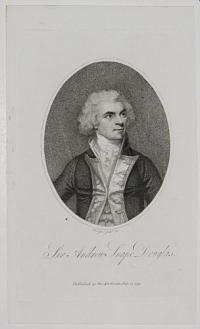
Sir Andrew Snape Douglas.
Orme Jun.r. Sculp.t. 1795.
Published as the Act directs, July 15 1795.
Stipple with large margins on 3 sides. Plate: 110 x 175mm (4¼ x 6¾").
Half portrait, in a roundel, of Sir Andrew Snape Douglas (1761-1797), a Scottish naval captain who served in the Royal Navy during the French Revolutionary Wars and the American War of Independence. He served on the court martial of Bligh.
[Ref: 33523] £80.00
(£96.00 incl.VAT)
![[The Honble. Arch.d Douglas.]](img-thumbnail/jpegs/15814.jpg)
[The Honble. Arch.d Douglas.]
G. Willison pinxit. Val. Green fecit.
Publish'd Octr. 22nd 1770, by G. Willison Greek Street, Soho, London.
Proof mezzotint, scratched letters and publication line, 422 x 605mm 16½ x 23¾ inches. Minor rubbing, minor printing imperfection in the plate in Justice's robes, stains lower left. In the final state the engraving carries a dedication, "To his Grace Charles Duke of Queensberry and Dover, This plate is most humbly Dedicated by His Grace's most obedient and obliged humble Servant. George Willison".
Allegorical portrait, bust-length to front within oval, held by figure of Justice, resting the image on carved pedestal and trampling Calumny beneath her feet; proof. Archibald Douglas, 1st Baron Douglas [1748–1827] litigant and politician. The relief medallions of Camden and Mansfield are references to the final decision in one of the eighteenth century's most famous legal battles. The Douglas Cause, was the challenge to Archibald's inheritance by the Hamiltons, who argued that he and his brother were supposititious. The Hamilton lawyers put together a plausible circumstantial argument that Archibald was actually Jacques Louis Mignon, the son of a Parisian glassworker, who had disappeared in July 1748. The case was litigated at great length and expense (the two sides spent £54,000 between them). It attracted tremendous interest, especially in Scotland. Not only was a large estate at stake, but many felt that requiring Archibald Douglas to in effect prove his identity raised a question that could endanger the security of inheritance in general. In Scotland the Douglas side enjoyed broad popular support, with James Boswell an especially eager partisan, though many of the literati favoured the Hamilton side. In 1767 the court of session decided by the casting vote of the lord president against Douglas. Douglas appealed to the House of Lords which, following the opinions of law lords Mansfield and Camden, reversed the decision without a division. Whitman 20.i. CS:39.i Ex: Collection of The Hon. C. Lennox-Boyd.
[Ref: 15814] £480.00
![[James Douglas, Duke of Morton] No 2 [scratched letters].](img-thumbnail/jpegs/52556.jpg)
[James Douglas, Duke of Morton] No 2 [scratched letters].
[Engraved by George Vertue? after Jacob Houbraken.]
[n.d., c.1740.]
Engraving, proof before title. 100 x 105mm (4 x 4¼"). Sitter identified in pencil.
James Douglas (c. 1516-81), 4th Earl of Morton, last of the four regents of Scotland during the minority of James VI.
[Ref: 52556] £65.00
(£78.00 incl.VAT)
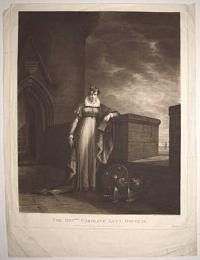
The Hon.ble Caroline Lucy Douglas. Proof.
Drawn by C.L.D. Engraved by W. Say Engraver to H.R.H. the Duke of Glocester.
London: Pub.d & Sold by Edwd. Orme, Printseller to the King & Royal Family Bond Str.t Corner of Brook Street.
Proof mezzotint. 610 x 480mm (24 x 18¾"). Trimmed to plate mark at top, margins agged, tear entering plate on right,
A self-portrait of the daughter of the 1st Baron Douglas of Douglas, Caroline Lucy Douglas (1784-1857) standing on battlements. She married Vice Admiral Sir George Scott. Ex Collection of the Hon. Christopher Lennoc Boyd. See Ref: 8282 for the pair.
[Ref: 56263] £240.00
(£288.00 incl.VAT)
![The Hon.ble Caroline Lucy Douglas [&] Capt.n The Hon.ble George Douglas R.N.](img-thumbnail/jpegs/8282.jpg)
The Hon.ble Caroline Lucy Douglas [&] Capt.n The Hon.ble George Douglas R.N.
Drawn by C.L.D. Engraved by W. Say Engraver to H.R.H. the Duke of Glocester.
London: Pub.d & Sold by Edwd. Orme, Printseller to the King & Royal Family Bond Str.t Corner of Brook Street. & Publication line trimmed away on George Douglas R.N.
Pair of mezzotints, possibly private plates. 608 x 478mm (24 x 18¾") [&] 595 x 478mm (23½ x 18¾"). Trimmed to plate mark second plate publication line lost minor foxing and outer edges a little dirty.
A fantastic pair of romantic portraits of the children of the 1st Baron Douglas of Douglas, by the daughter, Caroline Lucy Douglas (1784-1857, later known as Caroline Lucy Scott after marrying Vice Adml.Sir George Scott). The son, George Douglas (1788-1838), became a commander in the Royal Navy .
[Ref: 8282] £580.00
view all images for this item

Gulielmus Drummond de Hathornden Scotus, Historiographus et Poeta. Dedicated to the Right Honourable David Steuart Erskine, Lord Cardross L.L.D. F.R.S. F.S.A. by his much oblig'd, and most obedient Serv.t J. Finlayson.
Cornelius Johnson pinx.t J. Finlayson del.t. et fecit.
Publish'd according to Act of Parliamet, 1766 Juny 1.st = Sold at the Golden Lamp in Berwick Street, Soho. [c.1811.]
Mezzotint with very large margins, paper watermarked. Plate 381 x 280mm (15 x 11").
Portrait of William Drummond (1585-1649), Scottish poet & historian. CS: 5, iii/iii.
[Ref: 30910] £220.00
(£264.00 incl.VAT)
![[James Duff, 5th Earl Fife.]](img-thumbnail/jpegs/60961.jpg)
[James Duff, 5th Earl Fife.]
[Engraved by George Raphael Ward, from a Sketch by Francis Grant, A.R.A.]
[n.d., c.1850.]
Mezzotint, proof before letters. 590 x 400mm (23¼ x 15¾") very large margins. Some creasing, a few small nicks in margins.
Full length portrait of James Duff, 5th Earl of Fife (1814-79) in Highland dress, with kilt, sporran, sword, gun and dog. BM 2010,7081.5180, identifying him as James Duff, 4th Earl (1776-1857).
[Ref: 60961] £280.00
(£336.00 incl.VAT)
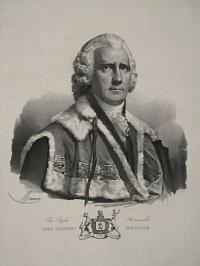
The Right Honourable Lord Viscount Melville.
Maurin [signed in plate.] Lith. de Villain, rue de Sevres, no. 23.
[Paris, c.1840.]
Lithograph, sheet 540 x 355mm. 21¼ x 14". Hole to sheet upper left corner. Slightly soiled.
Robert Dundas, 2nd Viscount Melville (1771 - 1851) was the son of Henry Dundas, 1st Viscount Melville. Dundas was Member of Parliament for Hastings in 1794, Rye in 1796 and Midlothian in 1801. He was also Keeper of the Signet for Scotland from 1800. He was appointed a privy counsellor in 1807, and was chancellor of the University of St Andrews from 1814. Melville filled various political offices and was First Lord of the Admiralty from 1812 to 1827, and from 1828 to 1830. He was the subject of the last impeachment trial ever held in the House of Lords in 1806 (acquitted). Publisher's blindstamp. After Sir Thomas Lawrence (1769 - 1830).
[Ref: 12377] £95.00
(£114.00 incl.VAT)

The Right Hon.ble Thomas Elder, of Forneth Lord Provost of the City of Edinburgh &c.
H. Raeburn, pinx.t. R. Earlom, sculp.t.
[n.d., c.1797.]
Mezzotint. 520 x 360mm (20½ x 14¼") very large margins. Plate mark cracked top and bottom.
Thomas Elder (1737-99), a wine merchant who served as Lord Provost of Edinburgh three times (1788-90, 1792-4 and 1796-8). Here he is portrayed with the plans for the new buildings of Edinburgh University, a scheme he was heavily involved with. Raeburn's portrait was painted in 1797 at the request of the principal and professors of the university, and is preserved in their court room.
[Ref: 48516] £360.00
![Edward Ellice [facsimile signature].](img-thumbnail/jpegs/48497.jpg)
Edward Ellice [facsimile signature]. Private Plate.
Painted by George Richmond R.A., D.C.L. Engraved by Thomas L. Atkinson.
[n.d., c.1875.]
Mezzotint on chine collé. 445 x 350mm (18 x 13¾").
Seated portrait of Edward Ellice the younger (1810-80), Scottish politician, son of a deputy-governor of the Hudson's Bay Company and nephew of Earl Grey. He served as Private Secretary to Lord Durham during his diplomatic mission to Russia (1832) and his governor generalship in Canda (1838), and was MP for St Andrews Burghs from 1837 until his death. His wife Katherine is remembered for watercolours she painted of the Patriote rebels who captured her in the rebellion of 1837-8. Ellis attended Trinity College, Cambridge.
[Ref: 48497] £130.00
(£156.00 incl.VAT)

William Fairbairn, Esq.re C.E. F.R.S. Proof.
Painted by Philip Westcott. Engraved by T.O. Barlow. Printed by W. Hatton.
Manchester, Published by Thomas Agnew & Sons, Publishers and Printsellers to the Queen _ Jan.y 1st 1852.
Proof mezzotint. Limited to 50 in this state. 505 x 380mm (20 x 15"). Printsellers' blind stamp. Very large margins.
Portrait of Sir William Fairbairn (1789-1874), 1st Baronet (of Ardwick), a Scottish civil engineer and shipbuilder, designer of the box girder system used by Robert Stephenson to build the Conway and Britannia Bridges. In this portrait Fairbairn points to a design sheet for the Conway Bridge, on which a letter to Stephenson rests. NPG D36920.
[Ref: 31800] £260.00
(£312.00 incl.VAT)

Adam Ferguson LL.D.
Painted by Sir Joshua Reynolds. Engraved by J. Beugo.
Publish'd Oct.r 23 1790 by J. Stockdale Piccadilly.
Engraving, with large margins. Plate 210 x 120mm. 8¼ x 4¾".
Portrait after Reynolds; half-length seated to front, eyes down to right, with quill pen in his right hand; corner of table with papers to right; oval. Adam Ferguson (1723-1816) was a Scottish philosopher, social scientist and historian of the Scottish Enlightenment. He is often referred to as "the father of modern sociology". He was professor of philosophy at Edinburgh. Hamilton: p.26.
[Ref: 25570] £75.00
(£90.00 incl.VAT)




![[Dervorguilla de Balliol]](img-thumbnail/jpegs/44077.jpg)
![[Dervorguilla de Balliol]](img-thumbnail/jpegs/44076.jpg)
![[Henry Blackwood]](img-thumbnail/jpegs/39433.jpg)

![David Brewster [facsimile signature.]](img-thumbnail/jpegs/24468.jpg)








![[Archibald Campbell, 1st Marquess of Argyll] Lo here, the Genius of the great Arguyle](img-thumbnail/jpegs/12548.jpg)






![John Douglas Edward Henry [Campbell]](img-thumbnail/jpegs/52845.jpg)

![Alex Chalmers [facsimile signature].](img-thumbnail/jpegs/35349.jpg)





![Yours always Allan Cunningham [pen facsimile.]](img-thumbnail/jpegs/24483.jpg)






![[The Honble. Arch.d Douglas.]](img-thumbnail/jpegs/15814.jpg)
![[James Douglas, Duke of Morton] No 2 [scratched letters].](img-thumbnail/jpegs/52556.jpg)

![The Hon.ble Caroline Lucy Douglas [&] Capt.n The Hon.ble George Douglas R.N.](img-thumbnail/jpegs/8282.jpg)

![[James Duff, 5th Earl Fife.]](img-thumbnail/jpegs/60961.jpg)


![Edward Ellice [facsimile signature].](img-thumbnail/jpegs/48497.jpg)

